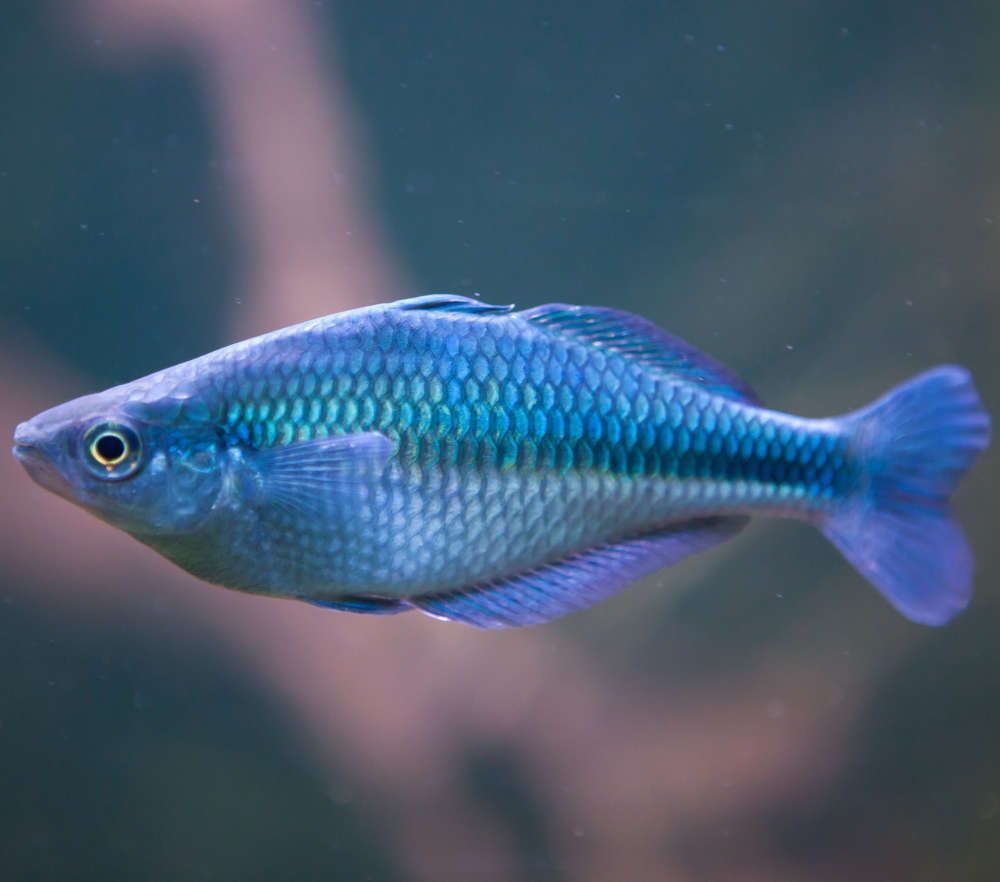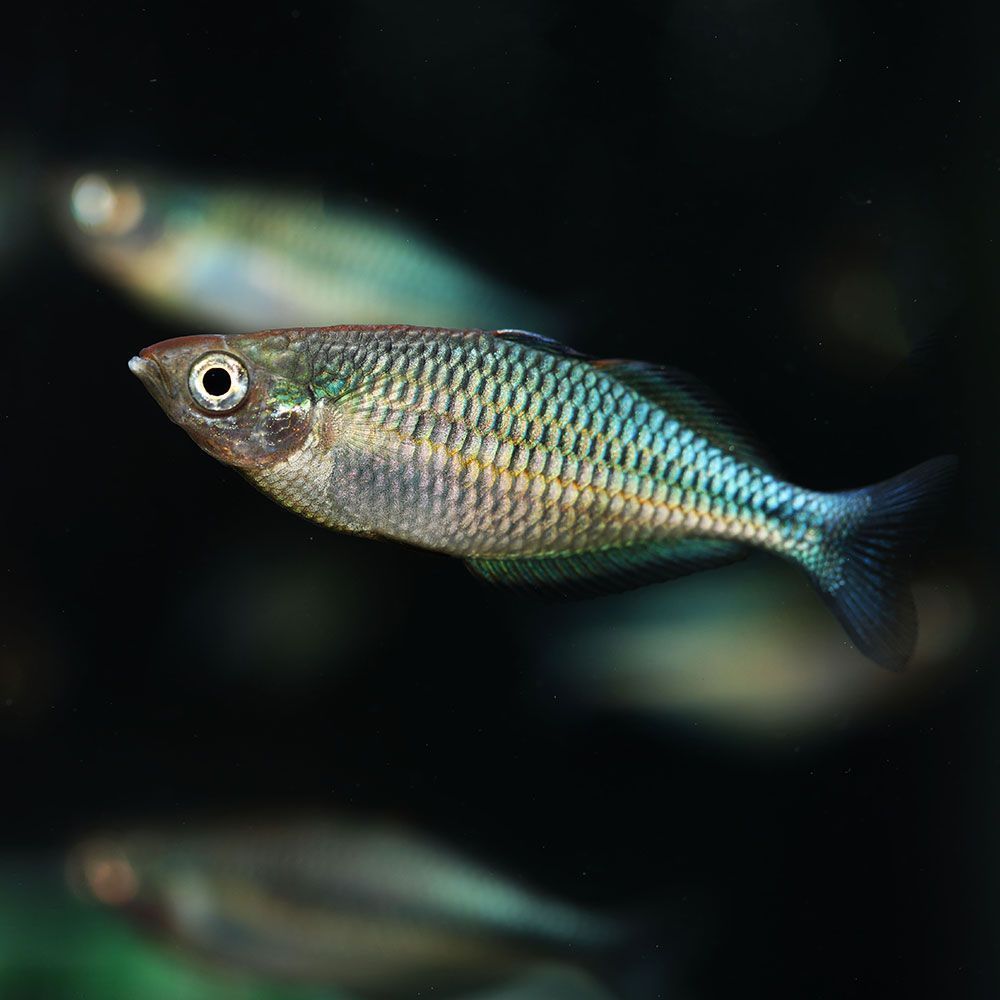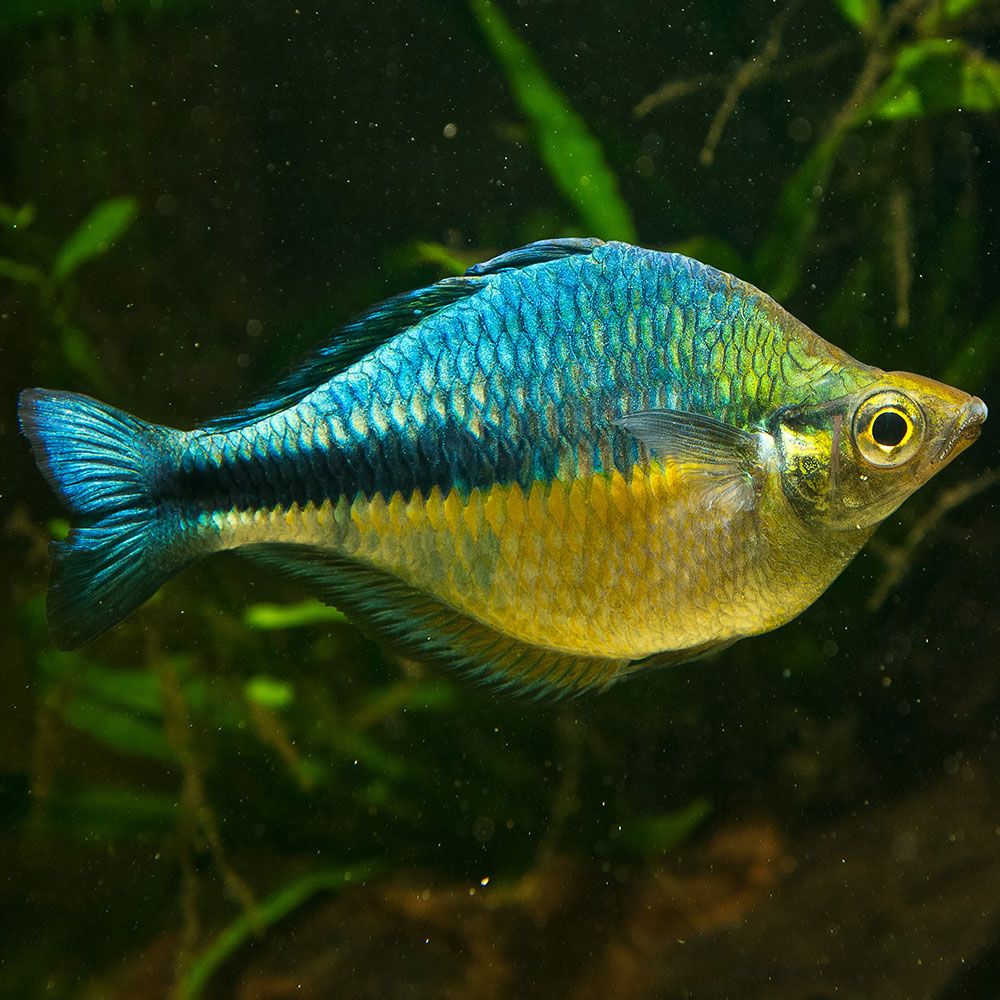It stands out with its unique color-changing abilities, is omnivorous and pretty docile during mealtime. Best of all, it’s great for peaceful yet lively community tanks!
So, if your interest has been piqued, read on!
What is a Turquoise Rainbowfish?
The turquoise rainbowfish is a lively freshwater species that can add a lot of fun to your tank. It is one of the most loved rainbows of all time, but sadly, the population of the fish is also declining.
| Origin | Lake Kutubu, Papua New Guinea |
| Order | Atheriniformes |
| Family | Melanotaeniidae |
| Scientific Name | Melanotaenia lacustris |
| Common Names | Turquoise rainbowfish, Lake Kutubu rainbowfish, and blue rainbowfish |
| IUCN Red List Status | Endangered |
| Appearance | Blue body, flat head with large eyes and a small mouth, sharp first dorsal fin, rounded second dorsal and anal fins |
| Size | Around 10 cm (4 in) in captivity and up to 12 cm (4.8 in) in the wild |
| Lifespan | 5-8 years |
| Temperament | Peaceful, might be aggressive towards unsuitable tankmates |
| Tank Level | Middle to top dwellers |
| Water Temperature | 68-77 °F (20-25 °C) |
| pH Level | 7-8 |
| Water Hardness | 10-12 dGH |
| Care Level | Intermediate |
| Minimum Tank Size | 30 gallons for 1 |
| Tank Environment | Sandy substrate, live plants, hiding spots, and lots of swimming space |
| Diet | Omnivorous |
| Tank Mates | Own group, other peaceful freshwater species |
What is the Natural Habitat of Turquoise Rainbowfish?
The turquoise rainbow fish is endemic to the Southern Highlands Province of Papua New Guinea. It inhabits Lake Kutubu and the River Soro, which originates from that lake.
In the lake, the fish mainly swim around the highly vegetated areas, which have lots of logs and roots.
According to The IUCN Red List Status of Threatened Species assessment of 2019, this fish was marked Endangered.
Which family does Turquoise Rainbowfish belong?
The turquoise rainbowfish belongs to the Melanotaeniidae family under the Atheriniformes order and is scientifically known as Melanotaenia lacustris.
Worldwide, this fish is also called by different common names, which are turquoise rainbowfish, Lake Kutubu rainbowfish, and blue rainbowfish.
Fun Fact: This species can change colors during the course of the day and show different shades at different times. The chromatophores and iridophores of the fish respond to its mood.
How does Turquoise Rainbowfish Look?

If you’re curious about how this fish looks, keep reading!
What is the Size of Turquoise Rainbowfish?
The average size of an adult turquoise rainbow fish in captivity is 10 cm (4 in). But the maximum reported size in the wild is 12 cm (4.8 in).
What is the Color of Turquoise Rainbowfish?
As its name suggests, the fish has a bright turquoise coloration on its body and a remarkable black or cobalt blue stripe along its body. Its abdomen is silver to yellow.
There are hints of orange and yellow on its anal and dorsal fins. With the reflection of light, its scale color seems to keep changing.
What are the Features of Turquoise Rainbowfish?
The turquoise rainbow fish boasts an elongated body, and as the fish ages, it becomes more deep-bodied. It has a slim, triangular head, large, deep-set eyes, and a small mouth.
The first sharp dorsal fin of this fish is quite identifiable.
The anal fin looks like the second-rounder dorsal fin, and it has transparent delicate pectoral and pelvic fins.
How does a male and female Turquoise Rainbowfish differ?
The male turquoise rainbow fish has a brighter coloration than the female. The mature male also has a larger body and an arched back.
The female fish is paler and less broad than the males. It is also calmer than the males, who can become aggressive at times. The male might have a pointier anal fin.
What is the Behavior of Turquoise Rainbowfish in the tank?
It is a peaceful yet energetic fish that can be naturally playful. But, if with unsuitable tank mates, it can turn quite aggressive.
Usually, the males don’t break out into fights. So, you can easily have a school of single-gender only. But it’s advised to keep the genders mixed to maintain the brightest colors.
What is the Lifespan of Turquoise Rainbowfish?
In a properly maintained tank, the turquoise rainbow fish lives around 5-8 years. Poor maintenance can drop its longevity a lot.
Author’s Note: The turquoise rainbowfish will get intensely colorful when it is very pleased with its living conditions and feels healthy.
How to Take Care of Turquoise Rainbowfish?

Now, if you’ve decided to get this fish, make sure you prepare the best home you can for it. So, to do this, read what we have said carefully!
What should be the Tank Size for Turquoise Rainbowfish?
This fish can be kept in a school of 5-6 members minimum, for which you will need a tank of 55 gallons.
For a single fish, you can use a tank of 30 gallons. These are very skilled jumpers, so use a lid on your tank.
What should be the Water Chemistry for Turquoise Rainbowfish?
The perfect water conditions keep your fish healthy and vibrant. So follow these values closely to give the best condition to your pet!
- pH Levels: 7-8
- Water Temperature: 68-77 °F (20-25 °C)
- Water Hardness: 10-12 dGH
- Carbonate Hardness: 10-20 dKH
- Ammonia: 0 ppm
- Nitrite: 0 ppm
- Nitrate: Below 20 ppm
What should be the Tank Environment for Turquoise Rainbowfish?
To help your pet fish live its best life, give it the most comfortable home by following the conditions below:
Which Substrate does Turquoise Rainbowfish need?
A dark sand substrate can be used to mimic the turquoise rainbowfish’s natural habitat and bring out its stunning color.
Which Plants does Turquoise Rainbowfish need?
Sturdy live plants will be able to withstand the boisterous swimming habits of the turquoise rainbowfish. So include plants like Anubias, Vallisneria, java fern, Amazon sword, and water sprite.
What type of Lighting does Turquoise Rainbowfish need?
This rainbowfish species does not need very bright lighting. Use a normal LED light with day-night settings according to your aquarium size.
Try to set up the aquarium in a place where it can get at least 1-2 hours of sunlight.
What Décor does Turquoise Rainbowfish need?
Use strategic décor like driftwood, bogwood, cave, and rocks to give your fish plenty of hiding spots for when it needs that. Make sure to add limited decor so the fish has enough space to swim.
Which Filter does Turquoise Rainbowfish need?
Use a robust oxygenating filter to manage healthy water parameters. A canister or power filter is a great choice.
What is the Water Flow Rate for Turquoise Rainbowfish Tank?
Turquoise rainbows prefer slow water flow like the almost still water of its native lake. So, try to maintain a gentle and even water flow rate.
Fish Care Tip: In my experience, this fish needs to be given time to acclimatize to the tank temperature. So, let the fish float on the tank while in its bag for 15-20 minutes. Then, add a little tank water in the bag for 5-10 minutes until an hour, after which you can slowly introduce fish to the tank.
What is the Food & Diet for Turquoise Rainbowfish?
The turquoise rainbowfish is an omnivorous, no-fuss eater. Ensure a balanced diet with both live and plant-based food to keep it healthy. This fish has a small mouth, so food needs to be smaller in size.
These are some of the foods you can include in your fish’s diet:
- Freeze-dried daphnia
- Brine shrimp
- Bloodworms
- Tubiflex
- Quality pellet
- Flakefood
- Ghost shrimp
Feed them 2-3 times a day, but only the amount that can be eaten within 5 minutes.
What are the Tank Mates for Turquoise Rainbowfish?
Since the turquoise rainbow fish is a schooling fish, you can keep it in a group of its own. You can house 5-6 turquoise rainbowfish together.
If you want a single-gender group, get 5 of them.
If you want a bigger group, get an equal number of males and females (for an even number of specimens: 6,8,10, etc.).
For an uneven number of specimens, make sure the extra one is a female. So, for a group of 7, 3 males and 4 females and so on.
As for other species, these do well with the following tankmates:
- Tetras
- Other rainbowfish species
- Rasboras
- Danios
- Characins
- Guppies
- Freshwater gobies
- Corydoras
- Suckermouth catfish
- Dwarf gouramis
- Cherry barbs
- Livebearers
- Discus
- Scavenger catfish
- Shrimps
- Crabs
- Snails
Which Tank Mates to Avoid for Turquoise Rainbowfish?
The turquoise rainbow fish is not great buddies with certain species. So, let’s know about some of them here:
- Aggressive fish: The rainbow may feel threatened.
- Fish with different water parameter needs: They can’t coexist in the same habitat.
- Timid, slow-moving fish: Rainbows are too boisterous and might stress the slow movers.
Such fishes are namely:
- Oscars
- Arowanas
- Jack Dempsey
- Other aggressive cichlids
- Red tail sharks
What are the Common Diseases in Turquoise Rainbowfish?
The turquoise rainbowfish is comparatively sturdy, but if you’re too careless, it may fall prey to the following diseases:
| Disease Name | Causes | Symptoms | Treatment |
|---|---|---|---|
| Ich | Protozoan Parasitic Infection | Flashing, white spots, inactivity, appetite loss | Raise water temperature, add aquarium salts or ich medication |
| Fin rot | Bacterial Infection | Fin discoloration or redness, inactivity, appetite loss, fin disintegration, fin fraying | Improve water quality, remove any object that may hurt the fish, add antibiotics |
| Gill or Skin flukes | Parasitic infection | Mucous on body, clamped fins | Change tank water, add appropriate additive medication |
| Dropsy | A build-up of body fluid | Bloated stomach, swimming at the bottom, going into hiding, lethargy, and loss of appetite | Salt baths and medication |
| Columnaris | Bacterial Infection | Inactivity, appetite loss, fin fraying, white patches | Reduce stress, add antibiotics, enhance water quality |
Quick Tip: To prevent most diseases, maintain suitable water parameters, feed a balanced diet, and quarantine new fish before adding them to a tank.
How to Breed Turquoise Rainbowfish in an Aquarium?
This species is quite easy to breed in an aquarium setting. If you want to successfully hatch fry, then follow what we say next!
How to Prepare the Tank for Breeding Turquoise Rainbowfish?
Prepare a 40-gallon breeding tank with breeding mesh or spawning mop to collect the eggs. Add fine-leaved plants as another option for the spawning site.
The water level should be low, and flow kept gentle for good results. Use an air-powered or sponge filter, and no substrate is required.
For best results, maintain the following water parameters:
- Water Temperature: 72-75 °F (22-24 °C)
- pH Levels: 7.5
What is the Pair Obtaining & Conditioning Process to Breed Turquoise Rainbowfish?
Begin by conditioning the entire group in a tank without any other species. Feed them plenty of live and frozen food.
When the fish is conditioned, the female will show a plump abdomen. The males will flaunt their colors to each other frequently and develop an orange color above the gill flap.
Choose the best colored and plumpest pair to introduce into the breeding tank.
What is the Mating Process for Turquoise Rainbowfish?
Slightly raise the tank temperature to trigger spawning.
The male will swim in front of the female and show a mating stripe on its forehead. It leads the female to the spawning mops.
This species is an egg scatterer and continuous spawner. They’ll lay eggs on the mops every day for a few days, weeks, or months.
When to Separate Turquoise Rainbowfish eggs with its parents?
This fish usually eats its own eggs, so you have to collect them before that happens. Place the eggs in a tank with the same water as the breeding tank and raise the fry separately from the parents.
When do Turquoise Rainbowfish eggs hatch?
The eggs will take about 5 to 12 days to hatch. When the fry hatch, feed them liquid fry food or infusoria to survive. This will continue until they are grown enough to consume small pieces of live food.
This process is quite sensitive and the fry requires great care till they are about 8 weeks old. Avoid feeding sinking food, as the fry doesn’t swim to the bottom levels to eat.
Breeding Tip: To avoid overwhelming the females, keep more females than males in the tank!
How to Buy Turquoise Rainbowfish?
The turquoise rainbowfish is much more expensive than other rainbows. So, make sure you choose healthy specimens with bright colors, intact fins, and lively behavior.
A word from FishInAquarium
A group of turquoise rainbowfish in your tank is a sight to feast your eyes upon! Their boisterous nature will never leave you short of entertainment.
Owing to their strong constitution, they rarely fall sick and are perfect for an intermediate aquarist.
So, if this article has been able to convince you to give some affection to this species, share it with your friends and other enthusiasts. Let them share this feeling as well.
And, if you have any other queries, drop us an email, and we will get back to you with a solid answer.


